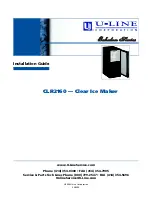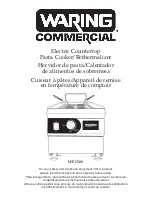
LABELER TYPE SETUP PROCEDURE
6-12
DUAL ACTION TAMP (DAT) SETUP (cont’d)
DAT SHOCK ABSORBERS AND FLOW CONTROLS
Both the Linear and Rotary Actuators have Shock Absorbers that need to be adjusted. The Swing Home
Shock has a Stop Collar installed. This Collar should be adjusted to provide 1/8” of shock travel. To
adjust the Shock so the Swing Arm stops in the right position, press the Manual Override on the Rotary
Actuator Valve and watch the movement of the Swing Arm. The Arm should hit the shock and stop
without bouncing. If it bounces too much, slow the Actuator down by adjusting the Flow Controls. The
Flow Controls are integrated into the Actuator and are located on each end of the longer cylinders. Turning
the screw in with a small screwdriver slows the Arm’s rotational speed and turning it out speeds the Arm
up. The Slide Shock Absorbers are larger and have longer strokes to ensure a smooth stop when moving
larger loads. The Shocks should be adjusted to ensure that there is at least 1/8” or more travel available
when the Slide Stop hits the body of the Slide. Do not allow the Shocks to bottom-out. To adjust the
Shocks, loosen the clamping screws on the Shock Mounts and screw the Shock in or out. When in
position, re-tighten the clamp to ensure the Shock stays in place. The Flow Controls for the Slide are
mounted on the Valve Bank. Screwing the knob in slows the speed of the Slide’s action while turning the
knob out speeds it up.
LABEL STATIC TEST
It’s important to know if the Applicator can consistently place labels in the same place on the product.
Without knowing this, you will not know whether label placement problems occurring on the line are due
to the Applicator or the product being labeled.
To test repeatability, configure the Applicator for Tamp Only Action. Position the Applicator with the
Tamp Assembly extended and the label pad approximately 1/8” away from the product. Jog several labels
onto the product. If the label stack is within the desired tolerances, go to the “Product Setup” section of
this insert. If not, go through the following suggestions to help find the problem.
1) Make sure that the labels are consistently stopping in the same place on the Label Pad. If this is OK go
to step 7; if not, go to step 2.
2) Check Label Stop. One label should be completely dispensed off the liner while the next label should
be 1/32” away from the Peel Edge Tip. If this varies more than 1/32” with each cycle, reset the Label
Sensor. If you still have the problem go to the Troubleshooting Section, page 10-1, of the 360a manual
and follow its suggestions. When this is corrected, go back and try the static test again. If this was OK,
go to step 3.
3) Make sure the Label Pad surface is clean. If clean, go to step 4. If not, clean and re-try the static test
again.
4) Make sure the vacuum is set correctly. If the label flutters while feeding across the pad, the vacuum is
too high. If the label falls off or moves after the label has left the liner, the vacuum is too low. If the
label feed looks smooth, go to the next step.
5) Work with the air pressure and the position of the Air Assist Tube until the label feeds more
consistently onto the Pad. Re-try the static test. If the results are still not good enough, go to step 6.
Otherwise go to 7.
6) Make sure you are working with good label stock. Try another roll of labels and see if you get the same
results.
7) Check the distance from the Label Pad to the product. If the distance is too large, the labels may float
too much. Try moving the Applicator so the Label Pad just clears the product (within 1/8”).
8) Is the Label Pad made for the label you’re using? Exposed holes on the Pad will reduce the available
vacuum used to hold the label in place and results will be uncertain.
Summary of Contents for 360a series
Page 47: ...GENERAL SETUP PROCEDURES 5 1 360a SERIES SETUP PROCEDURES...
Page 70: ...GENENRAL MAINTENANCE 8 1 360a SERIES GENERAL MAINTENANCE PROCEDURES...
Page 102: ...13 1 360 APPLICATOR DRAWINGS 360a SERIES CE MECHANICAL AND ELECTRICAL DRAWINGS...
Page 103: ......
Page 104: ......
Page 105: ......
Page 106: ......
Page 107: ......
Page 108: ......
Page 109: ......
Page 110: ......
Page 111: ......
Page 112: ......
Page 113: ......
Page 114: ......
Page 115: ......
Page 116: ......
Page 117: ......
Page 118: ......
Page 119: ......
Page 120: ......
Page 121: ......
Page 122: ......
Page 123: ......
Page 124: ......
Page 125: ......
Page 126: ......
Page 127: ......
Page 128: ......
Page 129: ......
Page 130: ......
Page 131: ......
Page 132: ......
Page 133: ......
Page 134: ......
Page 135: ......
Page 136: ......
Page 137: ......
Page 138: ......
Page 139: ......
Page 140: ......
Page 141: ......
Page 142: ......
Page 143: ......
Page 144: ......
Page 145: ......
Page 146: ......
Page 147: ......
Page 148: ......
Page 149: ......
Page 150: ......
Page 151: ......
Page 152: ......
Page 153: ......
Page 154: ......
Page 155: ......
Page 156: ......
Page 157: ......
Page 158: ......
Page 159: ......
Page 160: ......
Page 161: ......
Page 162: ......
Page 163: ......
Page 164: ......
Page 165: ......
Page 166: ......
Page 167: ......
Page 168: ......
Page 169: ......
Page 170: ......
Page 171: ......
Page 172: ......
Page 173: ......
Page 174: ......
Page 175: ......
Page 176: ......
















































